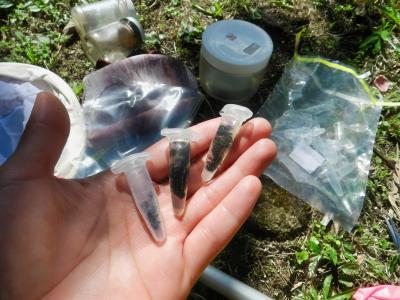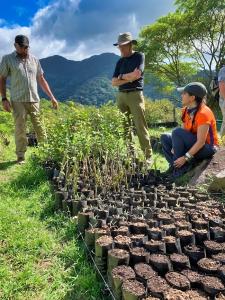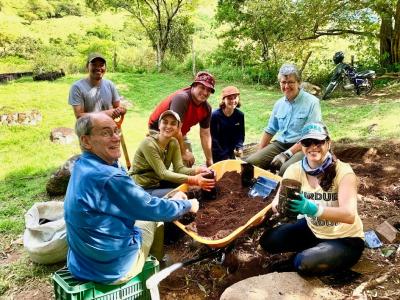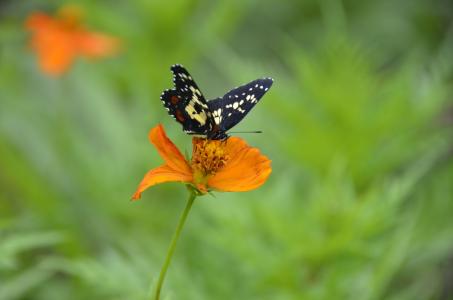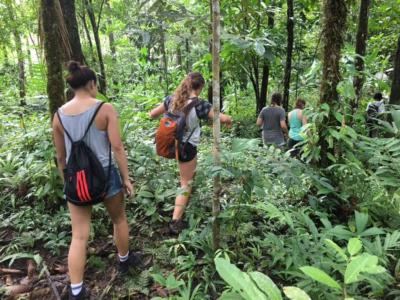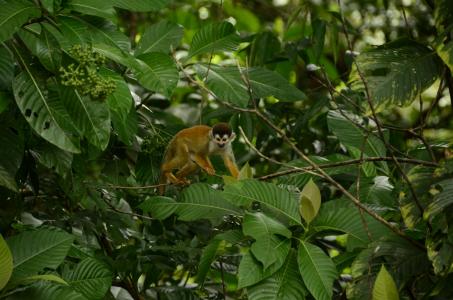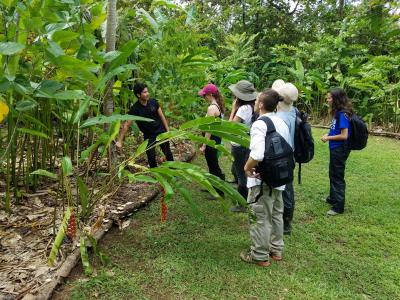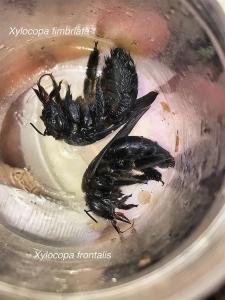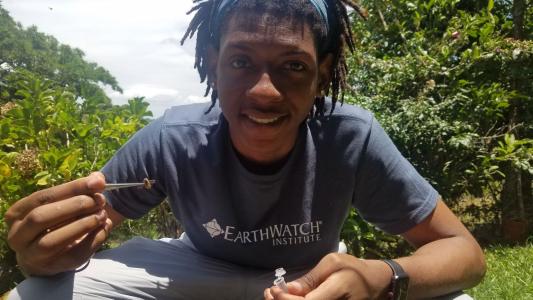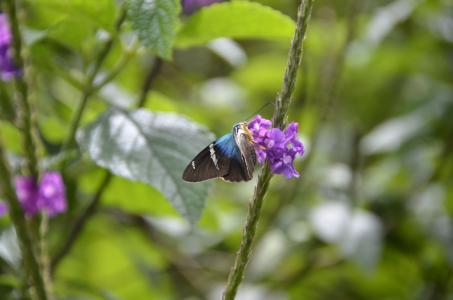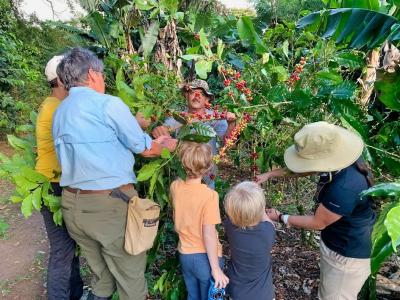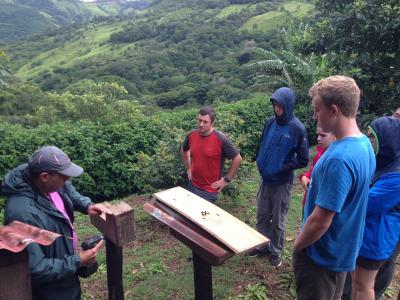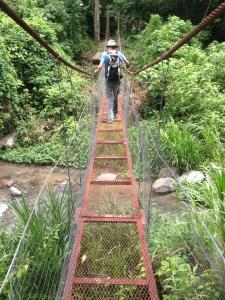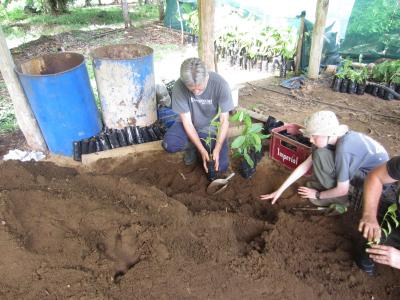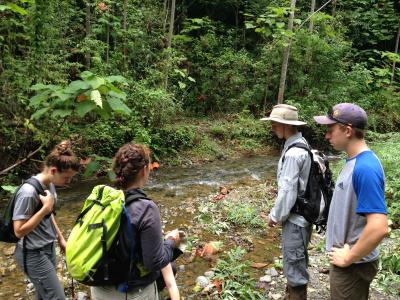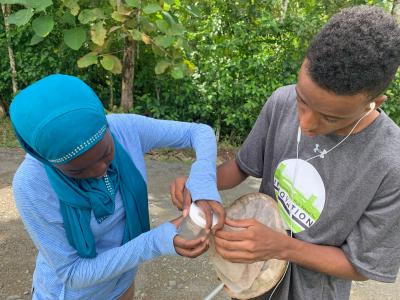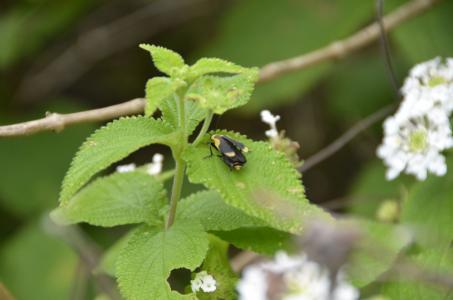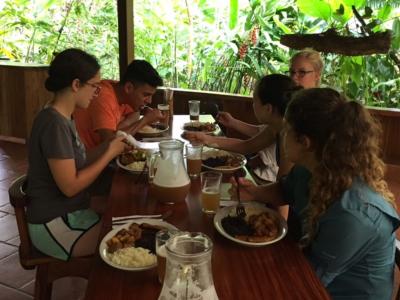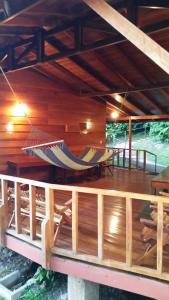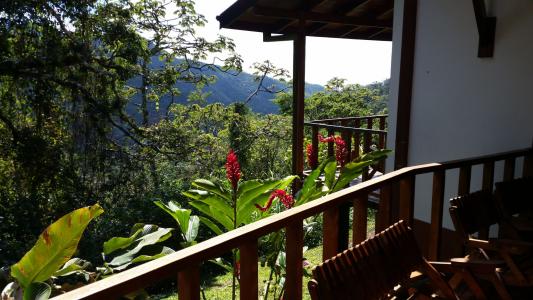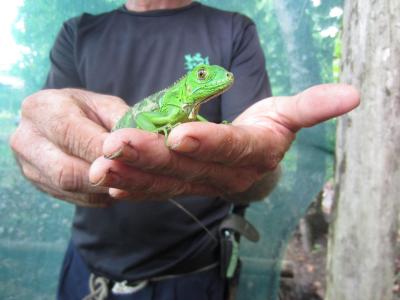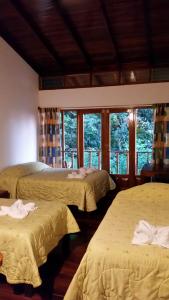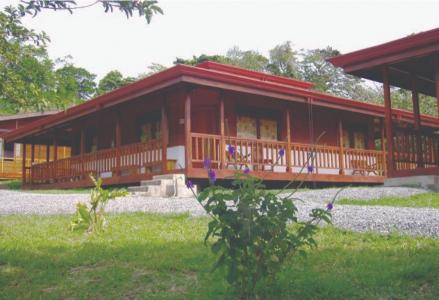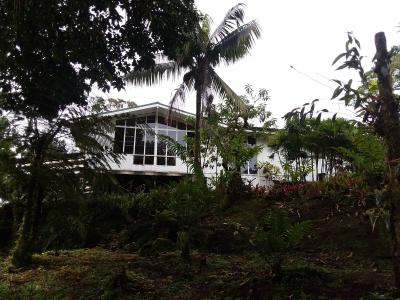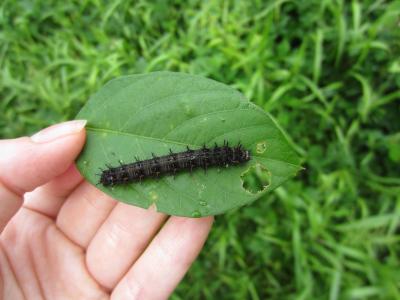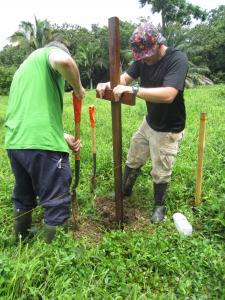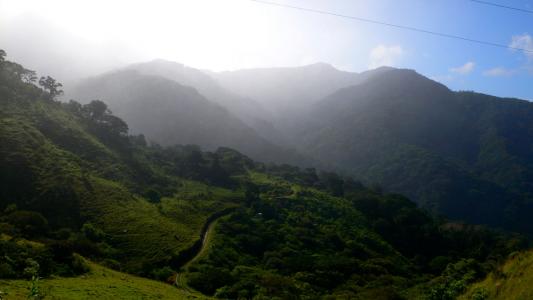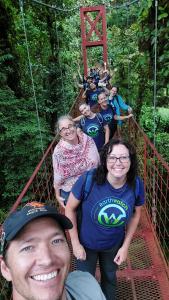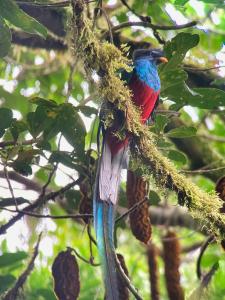.
Please read the following information before leaving for your expedition.
It provides the most accurate information available and will likely answer any questions you have about the project. You may also reach out to your Program Coordinator with any questions you may have.
Click on the images to view full size!
COVID-19 Safety
Please test for COVID-19 before traveling to your expedition; do not travel if you have tested positive, and call Earthwatch right away for the next steps. Visit earthwatch.org/covid-19 for more information on how you can help reduce the risk of COVID-19 impacting your expedition.
The Research
More than three-quarters of the world’s crops depend on pollinators. These animals provide essential ecosystem services and play a crucial role in producing many fruits and vegetables (Garibaldi et al., 2013). But, a changing climate, pesticide use, and habitat loss or degradation threaten pollinator communities, although the full impact of these threats is not well understood. For example, warming temperatures could force pollinator species to shift their ranges to higher elevations, which could impact agricultural production, or it could be that a changing climate will cause these species to disappear altogether.
Dependence on animal pollinators is even more important in the tropics than in the rest of the world, as nearly all tree species in the tropics are pollinated by diverse species of bees, hummingbirds, butterflies, and other pollinators (Bawa 1990). Throughout Central America, there are still many regions where it is largely unknown which species of pollinators are present and if pollinator species populations are declining or remaining stable (Freitas et al. 2009). To properly protect pollinators in these regions, it is critical to understand which species exist where, their impact on pollination services, and what the biggest threats to these pollinators are, such as changes in climate (Deutsch et al. 2008).
This project aims to address all three questions above by studying pollinators and pollination services over an elevational gradient that includes tropical dry forest, pre-montane, and montane forest in a semi-forested landscape. The findings from this project, combined with other research on pollinators in the region, could help Costa Rica become the first country in Central America to institute a national policy to protect pollinators. The project also aims to understand the most effective way to restore pollinator diversity and pollination services in the tropics and includes an experimental test of one restoration approach.
Conserving Wild Bees and Other Pollinators of Costa Rica
Research Aims
The research study has four core objectives:
- Understand how climate change and habitat loss will impact native bee species and the ecosystem service of pollination.
- Understand how agroforestry systems like silvopasture and home gardens can be managed to support pollinators and pollination services.
- Determine which plant species have the greatest potential for use in the restoration and conservation of pollinators and pollination services.
- Improve knowledge and taxonomy of Costa Rica bee species.
The expedition will take place in the Monteverde area of Costa Rica, along an elevational gradient that spans from the low-elevation towns of Sardinal and Guacimal to the San Luis Valley up to the Monteverde town. You will examine how pollinator species and the services they provide may be affected by a changing climate, including warming temperatures and changing precipitation patterns, in part by assessing their populations and interactions with flowering plant species at different elevations. Furthermore, the project will seek to understand whether these climate change responses may be mitigated by the presence of forests in the landscape. Also, beginning in 2023, we will be setting up experimental plots in the pasture to test the effectiveness of certain flowering shrub species in recovering pollinator communities and pollination services. Potential priority plant species for pollinators have been selected for the study, and these shrub species now need to be planted in experimental plots to test their role in pollinator recovery. Baseline data on bee communities in the plots needs to be collected alongside the planting of the shrubs. Post-planting, data on bee communities and pollination services using sentinel plants will be collected within the differing restoration treatments to test for their effectiveness in the recovery of pollinators.
Collected bees will contribute to the Bee Barcode of Life Initiative to ensure the bees are properly identified and create a database for future bee work.
Conserving Wild Bees and Other Pollinators of Costa Rica
How You Will Help
As an Earthwatch volunteer, you may be involved in any of the following research areas to help achieve the scientific objectives. Specifically, you will:
- Hand-collect bees and other pollinators from flowering plants using aerial nets and jars. All insect pollinators collected will be preserved in ethanol*. PI will later export specimens for identification at the EKU lab.
- Help identify plant species by taking photos and submitting them to iNaturalist or collecting specimens to be dried and mounted. Interaction networks will later be constructed to capture individual interactions between plant and bee species.
- Hike up the mountain to set out bee traps (small colored bowls and vane traps filled with soapy water). Collect traps at the end of the day and preserve collected specimens in ethanol. (This task will not occur on 2023 or 2024 teams.)
- A honey solution will be sprayed onto a patch of vegetation and used to attract stingless bees of the tribe Meliponini. Vegetation will be monitored for visitors to the honey solution, and the bees will be captured in jars. All bees will be taken to the lab at EKU for identification.
- Observe sentinel squash or pumpkin plants: Observe squash plants' flowers and collect all flower visitors to these plants. Across 30 home gardens spanning an elevational gradient from 200m–1500m above sea level. In July–August, fruits will be collected from these plants to quantify fruit size and pollination effectiveness.
- Collect baseline data on pollinator communities from experimental restoration plots in pastures using colored pan traps and vane traps.
- Plant or help maintain focal flowering shrub species in experimental restoration plots. Collect seeds or cuttings from forest trails or roadside and help maintain a plant nursery of these focal shrub species.
*This preservation process is essential to the research to best understand the area's wide variety of bee species. Scientists can only identify the majority of these tropical pollinator species with a microscope. Distinguishing the internal anatomical differences is key to helping determine which species are most at risk and to better direct conservation response. This method helps scientists understand which plant species support the most species-rich bee communities. The data, in turn, helps inform their recommendations to farmers about which plant species are best to plant for protecting bee communities.
Conserving Wild Bees and Other Pollinators of Costa Rica
Life in the Field
Monteverde has been at the forefront of field study in environmental protection since the 1960s when it began attracting scientists to marvel at its biodiversity. As a result, Monteverde is the ideal place to study ecology, conservation, sustainability, and agriculture and explore ways to protect its future, live more sustainably, and educate others to do the same.
This region is very mountainous and has a high elevation. Here, as you hike within or up the mountains daily, you will see breathtaking views of the Gulf of Nicoya and the overall landscape of Northeastern Costa Rica.
Teams staying at the San Luis de Monteverde site will complete the same research tasks at a lower elevation. Keep an eye out for white faced capuchin monkeys and white-throated magpie jays, as they are known to be more abundant and far more likely to be seen in this area.
Each day, you will have an opportunity to observe flowering plants to help quantify the importance of each plant species for pollinator communities. These plant flowering shrub species were previously identified to support higher numbers of pollinator species in restoration plots or participate in measuring other habitat variables that may be important for pollinator species.
Other activities may include preparing shrubs for restoration plots, planting trees in agroforests, talking to local farmers, setting out passive traps for collecting pollinators, and learning about different sustainable farms in the project area. These opportunities may vary across teams depending on the weather and what is logistically feasible at each team's time. There will be lots of walking and fun times, as well as collecting, identifying, and learning about the many pollinator species in the region.
ITINERARY
Weather and research needs can lead to changes in the daily schedule. We appreciate your cooperation and understanding.
Week 1 (“A” Team)
- The day before the team starts: Volunteers arrive in Costa Rica
- Day 1: Rendezvous, introductions, travel to accommodations
- Days 2–6: Fieldwork days
- Day 7: “A” team volunteers depart the project.
Week 2 (“B” Team)
- The day before the team starts: “b” team volunteers arrive.
- Day 7: Rendezvous, introductions, travel to field station (for "b" team volunteers)
- Days 8–12: Fieldwork days
- Day 13: The team departs.
Conserving Wild Bees and Other Pollinators of Costa Rica
Accommodations and Food
* Please note that not every expedition has couples’ or singles’ accommodations available. Please call or email Earthwatch to check availability before reserving your space(s) on the team.
- 2024 Team 2b (June 22–28, 2024), Team 4 (July 7–13, 2024), 2025 Team 1a (June 1–7, 2025), and Teen Team 4 (June 27–July 3, 2025) will stay in San Luis at the Tropical Agroforestry Institute. In January 2024, the TAI opened its doors to organized groups of students and farmers interested in learning about Agroforestry as a tool to enhance the economic and environmental performance of agricultural production systems. The institute comprises a 30-hectare farm in the beautiful San Luis Valley overlooking the Gulf of Nicoya. The website is currently working to be launched and will be available by the summer of 2024.
- All other 2024 and 2025 teams will stay at the Monteverde Preserve, owned by the Tropical Science Center (Centro Científico Tropical, or CCT). Detailed information can be found here on their website.
SLEEPING
At all sites, all bedding is provided, and beds are either full or bunk beds. Single or couples room requests are not guaranteed. They can only be accommodated depending on the available space at the accommodations and the total number of participants on the team at the time of the expedition. Please inform Earthwatch of a special rooming request in advance. Whenever possible, requests will be accommodated on a first-come, first-served basis. Single-gender* rooms are assigned with two to four volunteers per room.
* Earthwatch will honor each person’s assertion of gender identity respectfully and without judgment. For both teen and adult teams, where logistics dictate single-sex accommodations or other facilities, participant placements will be made in accordance with the gender identity the participant specified on their Earthwatch Participant form and/or preferences indicated in discussions with Earthwatch.
BATHROOMS
Bathrooms at all sites are shared. Showers and hot water are available at both sites, but the hot water is from solar power and can be used quickly, making hot water not always possible.
ELECTRICITY
You are welcome to bring electrical equipment. Electrical outlets in Costa Rica are 110v, just like in North America. However, although most wall outlets are switched to 3 prongs, if your device uses a 3-prong plug, we recommend bringing an adapter that converts from 3 to 2 prongs. Power can be unreliable at these remote locations, so come prepared for outages.
PERSONAL COMMUNICATIONS
All locations will have wireless internet access, which can sometimes be unreliable. You may bring your laptop or tablet for use during your free time. PIs and staff can be reached via telephone, cell phone, and email for emergencies and casual communication.
Please note: Earthwatch encourages volunteers to minimize outgoing calls and immerse themselves in the experience; likewise, family and friends should restrict calls to urgent messages only. Emergency communications will be prioritized.
FACILITIES AND AMENITIES
Monteverde Teams: CCT lodge is located at the Monteverde Cloud Forest Reserve entrance. Nearby is the Hummingbird café and two small gift shops. The reserve is well known for its diversity of birds, including quetzals, spider monkeys, and white-faced monkeys. Groups that stay here will have free access to the Reserve during their free time. The town of Santa Elena is about a 45-minute walk. Smoking is not permitted on the CCT campus in Monteverde.
San Luis de Monteverde Teams: The house is located in upper San Luis on a site that is being established as the Agroforestry Institute. Our plant nursery has many trial and demonstration agroforestry plots on site, with many more in the works. Within walking distance is the small rural town of San Luis, where you can find many farms and homes with cows, pigs, stingless beekeeping, horses, cats, dogs, coatis, lots of birds, and white-faced capuchin monkeys. Several small stores called Pulperias can be found in the town, and one is within walking distance of the house where teams will stay. Teams staying at this site will have the opportunity to visit the Monteverde Cloud Forest Reserve on their recreation day.
Guacimal Teams (none in 2024 or 2025): Guacimal houses are located on a large 112-hectare farm with cows, pigs, stingless beekeeping, horses, cats, dogs, mango trees, and a large, picturesque river running nearby. Howler monkeys are commonly seen and heard. Several small stores called Pulperias can be found in the town of Guacimal. Teams staying at this site will have the opportunity to visit the Monteverde Cloud Forest Reserve on their recreation day.
FOOD AND WATER
Most days will include bag lunches, but breakfast and dinner will be sit-down, family-style. Volunteers will not have to do meal prep or shopping.
Personal refrigerator space is only available for special circumstances, e.g., medicine storage.
Most meals are typical Costa Rican fare—beans, rice, vegetables, and poultry or beef, but occasionally, other options may be pasta, pizzas, or sandwiches.
TYPICAL MEALS
The following are examples of foods you may find in the field. Variety depends on availability. We appreciate your flexibility.
- Breakfast: Gallo pinto (rice and beans), eggs, toast, pancakes, arepas, cheese, plantains, fresh fruit, coffee
- Lunch: Sandwich bag lunch with peanut butter & jelly, or lunch meat and cheese options plus juice, cookies
- Dinner: Chicken, beef, or fish option, plus steamed vegetables and rice, beans, or pasta
- Dessert: Tres leches cakes, and other pastries, fruit, rice pudding
- Beverages: Fresh juice, water, coffee, hot chocolate
SPECIAL DIETARY REQUIREMENTS
Please alert Earthwatch to any special dietary requirements (e.g., diabetes, lactose intolerance, nut, other food allergies, vegetarian or vegan diets) as soon as possible, and note them in the space on your volunteer forms.
Vegetarians and vegans can be accommodated on this project somewhat if they are prepared to be flexible. Usually, there is plenty of food that meat and dairy can just be avoided, and avocados and beans will usually be good protein substitutes, but processed vegetarian meat substitutes are not available. The typical Costa Rican diet does not include much dairy, so lactose intolerance should be easy to accommodate. Wheat-based foods are also not typical in Costa Rica (rice is the primary grain consumed), so a gluten-free diet should be easily accommodated with sufficient notice.
Conserving Wild Bees and Other Pollinators of Costa Rica
Project Conditions
The following information is as accurate as possible, but please remember that conditions may change.
The project takes place along a tropical elevational gradient that spans three life zones: Tropical Dry Forest, PreMontane Forest, and Montane Forest. The elevational gradient is along a main road leading to the world-famous Monteverde Cloud Forest Reserve, encompassing three main towns: Guacimal, San Luis, and Monteverde.
Field sites will be farms or home gardens located off the main road. Because the field sites are scattered among the elevational gradient, project conditions can vary based on the elevation you are sampling each day.
- Monteverde falls within the Montane life zone, with average daily highs of 75°F and lows of 65°F.
- San Luis de Monteverde is at approximately 1100m elevation in the premontane life zone, with average daily highs of 80°F and lows of 65°F.
- Guacimal and the lower half of San Luis (200–800m elevation) are considered to lie within the tropical dry forest life zone where the average daily high temperature is 88°F and the low is 74°F. San Luis spans 800–1100m and falls within the pre-montane life zone, with average daily highs of 80–84°F and lows of 70–74°F.
The rainy season is from May to October; these months can feel cooler when heavy rains or fine mist occur. The dry season from December to April can be extremely windy.
The terrain here is rocky and mountainous, with some field sites offering spectacular views of the Golfo de Nicoya. In contrast, other sites provide views of the forested peaks of the Monteverde Reserve. Rainbows and double rainbows are frequently observed. 265 bird species have been observed in the San Luis Valley during Christmas counts and other observations. White-faced monkeys, howler monkeys, agoutis, and coatis are commonly seen among mammals.
While daily fieldwork and tasks may occur anywhere along the elevational gradient, the accommodations for most weeks will be in Monteverde. However, to increase the logistical ease of collecting data from field sites at the lowest elevations along the gradient, some weekly accommodations will be in San Luis or Guacimal towns.
GENERAL CONDITIONS
Please visit wunderground.com and search your project location for weather and region-specific information.
Conserving Wild Bees and Other Pollinators of Costa Rica
Essential Eligibility Requirements
All participants must be able to:
- Hike up to 2–5 miles daily over steep, slippery mountain terrain.
- Enjoy being outdoors all day in all types of weather, including rain, heat, and humidity, in the potential presence of insects, snakes, and other wild animals. Fieldwork will continue in rainy conditions.
- Watch footing while moving through dense, tangled vegetation.
- Get low enough to the ground to plant tree seedlings and other plants and collect bees from bowl traps.
- Carry personal daily supplies such as lunch, water, and some small field equipment.
- Be comfortable in vehicles moving along steep, winding, and occasionally bumpy roads for up to an hour. The drive between the SJO airport and the accommodations is the longest and can induce motion sickness for susceptible people.
- Get yourself up into and down out of a four-wheel-drive vehicle, minibus, or car and ride, seated, with a seatbelt fastened.
- Be able to get along with a variety of people from different backgrounds and ages, often in close proximity, for the duration of your team.
- Follow verbal and/or visual instructions independently or with the assistance of a companion.
- Take an active role in one’s safety by recognizing and avoiding hazards if and when they arise (including, but not limited to, those described in Earthwatch materials and safety briefings). Always comply with project staff instructions and recommended safety measures.
- Be able to effectively communicate with the staff if they are experiencing distress or need assistance.
- Be able to get along with a variety of people from different backgrounds and ages, often in close proximity, for the duration of the team.
- Be comfortable being surrounded by a language and/or culture that is not your own.
Conserving Wild Bees and Other Pollinators of Costa Rica
Health and Safety
EMERGENCIES IN THE FIELD
Project staff members are not medical professionals.
The project will have cell phones and two-way radios for communication among the team while conducting fieldwork.
Earthwatch has a 24-hour, 7-day-a-week emergency hotline number. Someone is always on call to respond to messages that come into our live answering service.
IMMUNIZATIONS & TRAVEL VACCINATIONS
Please be sure your routine immunizations are up to date (for example, diphtheria, pertussis, tetanus, polio, measles, mumps, rubella, and varicella) and that you have the appropriate vaccinations for your travel destination. Medical decisions are the responsibility of each volunteer and their doctor. Visit the Center for Disease Control and Prevention or the World Health Organization for guidance on immunizations.
If traveling from countries or regions where yellow fever is endemic, you must have a certificate of vaccination.
Staying up to date with your COVID-19 vaccinations, including receiving booster doses, as applicable, is strongly encouraged.
Conserving Wild Bees and Other Pollinators of Costa Rica
Project Risks and Precautions
Project Risks and Precautions
TRANSPORTATION
We may encounter poor road conditions, including landslides. Only qualified, experienced drivers will transport volunteers in project vehicles; we ensure project vehicles are well maintained. Seatbelts must be worn at all times. Volunteers are not permitted to drive. Driving after dark will be avoided, except in cases of emergency.
HIKING
You’ll likely traverse uneven terrain and hike uphill in humid tropical conditions; there’s a risk of sprains, strains, bruises, or breaks due to falling or tripping. You should never walk ahead of your team leader and should follow the leader’s instructions. Wear appropriate footwear, with good treads and ankle support, while hiking. You may wish to use a walking stick to help with balance while hiking.
ANIMALS
Venomous snakes are present in the area. Team members should wear tall rubber boots or snake guards in the field and should under no circumstances attempt to handle snakes. You’ll likely encounter many insects; wear long-sleeved shirts and long pants and apply insect repellent frequently to avoid bites. Those with insect allergies should bring the proper emergency treatment (such as an Epi-pen, with spares) and inform staff of the problem and the location of the treatment; they should take special precautions while collecting field data. While hiking, we may encounter plants with irritating spines or sap. These plants are easy to avoid if you do not reach out or touch them while hiking.
CLIMATE/WEATHER
Dehydration, heat exhaustion, sunburn, and other heat-related illnesses can occur, but you can protect yourself by drinking sufficient water, wearing high-SPF sunscreen, and wearing appropriate clothing. Dehydration from sweating can be a problem; please bring your water bottles that you can easily carry and refill them with electrolyte-replacing packets.
Because of the high humidity, people who use a hearing aid device may find it doesn’t work properly. Consider purchasing a hearing aid dehumidifier. You must be able to stay outside in the rain for extended periods.
PERSONAL SECURITY
Avoid areas designated as off-limits by project staff.
DISTANCE FROM MEDICAL CARE
Depending on where daily research activities take you, it may take an hour to reach the nearest hospital or more to arrange transport and reach the hospital. If you have a chronic condition that could require immediate medical care (e.g., heart conditions, kidney problems, severe asthma, etc.), or if you are pregnant, please discuss your participation on this expedition with your physician.
DISEASES
All volunteers should see a travel doctor before leaving to discuss immunizations and other precautions against tropical diseases.
COVID-19 DISEASE RISKS
COVID-19 remains an evolving risk to communities and individuals around the world.
Earthwatch strongly encourages you to stay up to date with your vaccinations, including receiving booster doses if available, and to continue to limit your exposure before your program, such as wearing a mask during travel and frequently washing your hands. Persons with a higher risk of severe illness from COVID-19 should consult with their healthcare provider before participation.
If you, or another person on site, display symptoms of illness or test positive for COVID-19, you may be required to wear a mask, test for COVID-19, seek medical advice, isolate/quarantine on- or off-site, cease or limit participation in program activities, and/or take other precautions. If local conditions or recommendations from authorities change, additional requirements may be implemented.
If you must isolate or depart from a program due to COVID-19 or other illness, you will not be entitled to a refund of the contribution for the program, nor any expenses resulting from your participation in the program or a disruption of your travel plans. We strongly encourage you to purchase travel insurance that will cover this eventuality.
Conserving Wild Bees and Other Pollinators of Costa Rica
Travel Planning
Either the Holiday Inn Express San José Airport Costa Rica or the San José International Airport (SJO). Details will be confirmed in your expedition Logistics Document once booked on a team.
Specific travel planning details will be provided in your Earthwatch Expedition Logistics Document. This document can be found in your MyEarthwatch Portal once you enroll. Please do not book travel arrangements—such as flights—until the Expedition Logistics Document matching the current year has been published to your portal account.
ABOUT YOUR DESTINATION
Earthwatch strongly recommends that travelers investigate their destination before departure. Familiarity with the destination’s entry/exit requirements, visas, local laws, and customs can ensure smooth travel. The U.S. Department of State's Traveler’s Checklist and Destination Guides are helpful resources. For LGBTI travelers, the U.S. Department of State's LGBTI Travelers page contains many useful tips and links.
COUNTRY AND PROJECT ENTRY REQUIREMENTS
You are responsible for reviewing and abiding by your destination's entry/exit requirements.
Entry visa requirements differ by country of origin, layover, and destination and do change unexpectedly. For this reason, please confirm your visa requirements at the time of booking and again 90 days before travel. Please apply early for your visa (we recommend starting six months before the start of your expedition). Refunds will not be made for volunteers canceling due to not obtaining their visa in time to meet the team at the rendezvous. You can find up-to-date visa requirements at the following website: travisa.com.
If a visa is required, participants should apply for a TOURIST visa. Please note that obtaining a visa can take weeks or even months. We strongly recommend using a visa agency to expedite and simplify the process.
Conserving Wild Bees and Other Pollinators of Costa Rica
Resources
ARTICLES
- Bee observer cards to learn your bees! greatsunflower.org/node/1000280
- Vanbergen AJ, and Insect Pollinators Initiative. 2013. Threats to an ecosystem service: pressures on pollinators. Frontiers in Ecology and the Environment 11: 251–259.
- Garibaldi LA, et al. 2014. From research to action: enhancing crop yield through wild pollinators. Frontiers in Ecology and the Environment 12: 439–447.
BOOKS
- Bees: An Up Close Look at Pollinators Around the World. By Sam Droege and Laurence Packer
PROJECT-RELATED WEBSITES
LITERATURE CITED
- Bawa, K.S. 1990. Plant–pollinator interactions in tropical rain forests. Annual Review of Ecology and Systematics 21: 399–422.
- Deutsch, C.A., J.J. Tewksbury, R.B. Huey, K.S. Sheldon, C.K. Ghalambor, D.C. Haak, P.R. Martin. 2008. Impacts of climate warming on terrestrial ectotherms across latitude. PNAS 105: 6668–6672.
- Freitas, B.M., V.L. Imperatriz–Fonseca, L.M. Medina, A.M.P. Kleinert, L. Galetto, G. Nates–Parra, J.J.G. Quezada–Euan. 2009. Diversity, threats, and conservation of native bees in the Neotropics. Apidologie 40: 332–346.
- Garibaldi, L.A., I. Steffan–Dewenter, R. Winfree, M.A. Aizen, R. Bommarco, S.A. Cunningham, C. Kremen, L.G. Carvalhiero, L.D. Harder, O. Afik, I. Bartomeus, F. Benjamin, V. Boreux, D. Cariveau, N.P. Chacoff, J.H. Dudenhoffer, B.M. Freita s, J. Ghazoul, S. Greenleaf, J. Hipolito, A. Holzschuh, B. Howlett, R. Isaacs, S.K. Javorek, C.M. Kennedy, K.M. Krewenka, S. Krishnan, Y. Mandelik, M.M. Mayfield, I. Motzke, T. Munyuli, B.A. Nault, M. Otieno, J. Petersen, G. Pisanty, S.G. Potts, R. Rader, T.H. Ricketts, M. Rundlof, C.L. Seymour, C. Schuepp, H. Szentgyorgyi, H. Taki, T. Tscharntke, C.H. Vergara, B.F. Viana, T.C. Wagner, C. Westphal, N. Williams, A.M. Klein. 2013. Wild Pollinators enhance fruit sets of crops regardless of honeybee abundance. Science 339: 1608–1611.
Conserving Wild Bees and Other Pollinators of Costa Rica
Sign up for the Earthwatch Newsletter
Be the first to know about new expeditions, stories from the field, and exciting Earthwatch news.
.
.
.
